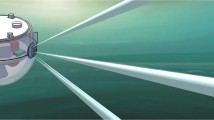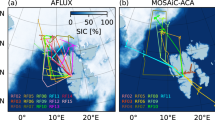Abstract
The second Arctic Gas and Aerosol Sampling Program (AGASP-II) was conducted across the Alaskan and Canadian Arctic in April 1986, to study the in situ aerosol, and the chemical and optical properties of Arctic haze. The NOAA WP-3D aircraft, with special instrumentation added, made six flights during AGASP-II. Measurements of wind, pressure, temperature, ozone, water vapor, condensation nuclei (CN) concentration, and aerosol scattering extinction (bsp) were used to determine the location of significant haze layers. The measurements made on the first three flights, over the Arctic Ocean north of Barrow and over the Beaufort Sea north of Barter Island, Alaska are discussed in detail in this report of the first phase of AGASP II. In the Alaskan Arctic the WP-3D detected a large and persistent region of haze between 960 and 750 mb, in a thermally stable layer, on 2, 8, and 9 April 1986. At its most dense, the haze contained CN concentrations >10,000 cm−3 and bsp of 80×10−6 m−1 suggesting active SO2 to H2SO4 gas-to-particle conversion. Calculations based upon observed SO2 concentrations and ambient relative humidities suggest that 104–105 small H2SO4 droplets could have been produced in the haze layers. High concentrations of sub-micron H2SO4 droplets were collected in haze. Ozone concentrations were 5–10 ppb higher in the haze layers than in the surrounding troposphere. Outside the regions of haze, CN concentrations ranged from 100 to 400 cm−3 and bsp values were about (20–40)×10−6 m−1. Air mass trajectories were computed to depict the air flow upwind of regions in which haze was observed. In two cases the back trajectories and ground measurements suggested the source to be in central Europe.
Similar content being viewed by others
References
Barrie, L. A., 1986, “Arctic air pollution: An overview of current knowledge”, Atmos. Environ. 20, 643–663.
Barrie, L. A., den Hartog, G., Botteriheim, J. W., and Landsberger, S., 1989, “Anthropogenic aerosols and gases in the lower troposphere at Alert Canada in April 1986”, J. Atmos. Chem., this issue.
Barrie, L. A., and Hoff, R. M., 1984, “The oxidation rate and residence time of sulphur dioxide in the Arctic Atmosphere”, Atmos. Environ., 18, 2711–2722.
Bodhaine, B. A., 1986, “The Barrow aerosol record, 1976–1984”, Atmos. Air Pollution, B., Stonehouse, (ed.), Cambridge Univ. Press, Cambridge, England, 159–174.
Bodhaine, B. A., Dutton, E. G., DeLuisi, J. J., Herbert, G. A., Shaw, G. E., and Hansen, A. D. A., 1989, “Surface aerosol measurements at Barrow during AGASP II”, J. Atmos. Chem., this issue.
Bridgman, H. A., Schnell, R. C., and Herbert, G. A., Bodhaine, B. A., and Oltmans, S.J., 1989, “Major haze event near Point Barrow, Alaska during AGASP II, April 2–3, 1986”, Atmos. Environ., submitted.
Bridgman, H. A., Schnell, R. C., and Herbert, G. A., Bodhaine, B. A., and Oltmans, S. J., 1989, “Meteorology and haze structure during AGASP II: Canadian Arctic flights, April 13–16, 1986”, J. Atmos. Chem., this issue.
Chaun, R. L., 1989, “Physical and chemical characteristics of aerosol particles collected during AGASP-II”, J. Atmos. Chem., to appear.
Doyle, G. J., 1961, “Self nucleation in the sulfuric acid-water system”, J. Chem. Phys. 35, 795–799.
Flyger, H., Heidam, N. Z., Hansen, K., Megan, W. J., Walther, E. G., and Hogan, A. W., 1976, “The background level of the summer tropospheric aerosol, sulphur dioxide and ozone over Greenland and the North Atlantic Ocean, J. Aerosol. Sci. 7, 103–140.
Hansen, A. D. A., and Novakov, T., 1989, Aerosol black carbon measurements in the Arctic troposphere, J. Atmos. Chem., this issue.
Harris, J. M., 1982. The GMCC atmospheric trajectory program, NOAA Tech. Memo. ERL ARL-116, NOAA Environmental Research Laboratories, Boulder, CO., 30 pp.
Harris, J. M., 1984, Trajectories during AGASP, Geophys. Res. Lett. 11, 453–456.
Herbert, G. H., Bridgman, H. A., Schnell, R. C., Bodhaine, B. A., and Oltmans, S. J., 1987, “The analysis of meteorological conditions and haze distributions for the second Arctic Gas and Aerosol Sampling Program (AGASP-II), April 1986”, NOAA Tech. Memo., ERL ARL-158, NOAA Air Resources Laboratory, Boulder, CO, 1–65.
Hoff, R. M., 1988, “Vertical studies of Arctic Haze by lidar”, J. Chem. Appl. Meteorol., (in press.).
Hogan, A. W., Barnard, S. C., Kebschull, K., Townsend, R., and Samson, J. A., 1984, “Aerosol variation in the western hemispheric Arctic”, J. Aerosol Sci. 15, 13–33.
Hoppel, W. A., 1975, “Growth of condensation nuclei by heteromolecular condensation”, J. Resch. Atmos. 9, 167–180.
Iverson, T., 1984, “On the atmospheric transport of pollution to the Arctic”, Geophys. Res. Lett. 11, 457–460.
Lowenthal, D. H., Rahn, K. A., 1985, “Regional sources of pollution aerosol at Barrow, Alaska, during winter 1979–1980 as deduced from elemental tracers”, Atmos. Environ. 19, 2011–2024.
Mirabel, P., and Katz, J. C., 1974, “Binary homogeneous nucleation as a mechanism for the formation of aerosols”, J. Chem. Phys. 60, 1138–1144.
Raatz, W. E., Schnell, R. C. and Bodhaine, B. A., 1985a, “The distribution and transport of pollution aerosols over the Norwegian Arctic on 31 March and 4 April 1983”, Atmos. Environ. 19, 2135–2142.
Raatz, W. E., Schnell, R. C., Bodhaine, B. A., and Oltmans, S. J., 1985b, “Observations of Arctic haze during polar flights from Alaska to Norway”, Atmos. Environ. 19, 2143–2151.
Raatz, W. E., Schnell, R. C., Bodhaine, B. A., Oltmans, S. J., and Gammon, R. H., 1985c, “Air mass characteristics in the vicinity of Barrow, Alaska, 9–19 March 1983”, Atmos. Environ. 19, 2127–2134.
Radke, L. F., Lyons, J. H., Hegg, D. A., Hobbs, P. V., and Bailey, I. H., 1984, “Airborne observations of Arctic aerosols, I: Characteristics of Arctic haze”, Geophys. Res. Lett. 11, 393–396.
Rahn, K. A., and McCaffrey, R. J., 1980, “On the origin and transport of the winter Arctic aerosol, Ann. N. Y. Acad. Sci. 338, 486–503.
Reiss, H., 1950, The kinetics of phase transitions in binary systems, J. Chem. Phys. 18, 840.
Roedel, W., 1979, Measurements of sulfuric acid saturation vapor pressure: implications for aerosol formation by heteromolecular nucleation, J. Aerosol Sci. 10, 375–386.
Saucier, W. J., 1955, Principles of Meteorological Analysis, Univ. of Chicago Press, Chicago, IL, 438 pp.
Schnell, R. C., 1984, “Arctic haze and the Arctic Gas and Aerosol Sampling Program (AGASP)”, Geophys. Res. Lett. 11, 361–364.
Schnell, R. C., and Raatz, W. E., 1984, “Vertical and horizontal characteristics of Arctic haze during AGASP: Alaskan Arctic, Geophys. Res. Lett. 11, 369–372.
Schnell, R. C., Watson, T. B., and Bodhaine, B. A., 1989, “NOAA WP-3D instrumentation and flight operations on AGASP-II”, J. Atmos. Chem., this issue.
Shapiro, M. A., 1985, “Dropwindsonde observations of an Islandic low and a Greenland mountain-lee wave”, Mon. Wea. Rev. 113, 680–683.
Shaw, G. E., 1985, “On very small particles in the Alaska Arctic troposphere”, J. Rech. Atmos. 19, 235–242.
Sheridan, P. J., 1989, “Analytical electron microscope studies of size segregated particles collected during AGASP-II, Flights 201–203”, J. Atmos. Chem., this issue.
Shugard, W. J., Heiss, R. H., and Reiss, H., 1976, “Theory of vapor phase nucleation in binary mixtures of H2O and H2SO4”, J. Chem. Phys. 61, 5298–5305.
Stauffer, D., Mohnen, V. A., and Hiang, S., 1973, “Heteromolecular condensation growth applied to particle growth”, J. Aerosol Sci. 4, 461–471.
Thornton et al, 1989, “SO2 measurements on AGASP-II”, J. Atmos. Chem., this issue.
Twomey, S., 1977, Atmospheric Aerosols, Elsevier Sci. Pub. Co., Amsterdam, Nethes, 302 pp.
Yount, M. E., Miller, T. P., and Gamble, B. M., 1987, “The 1986 eruption of Augustine volcano, Alaska: Hazards and effects” T. D., Hamilton and J. P., Galloway (eds.), in Geologic Studies of Alaska, U. S. Geological Survey Circular 998, U.S.G. S., Federal Center, Denver, CO, 195 pp.
Author information
Authors and Affiliations
Rights and permissions
About this article
Cite this article
Herbert, G.A., Schnell, R.C., Bridgman, H.A. et al. Meteorology and haze structure during AGASP-II, Part 1: Alaskan Arctic flights, 2–10 April 1986. J Atmos Chem 9, 17–48 (1989). https://doi.org/10.1007/BF00052823
Received:
Issue Date:
DOI: https://doi.org/10.1007/BF00052823




